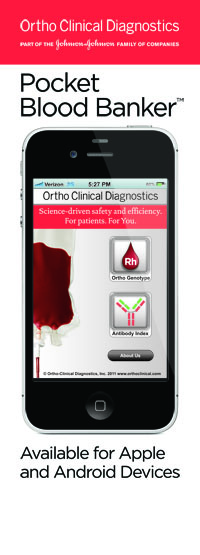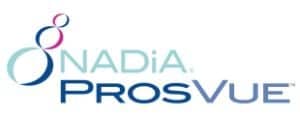Strategies for success
By: Celia Tombalakian, MSc, MBA

Every year, the AABB (formerly American Association of Blood Bankers) Annual Meeting offers blood banking professionals an opportunity to better understand the latest transfusion medicine technologies, state-of-the-art products and services, and opportunities for career advancement. This year’s 2012 meeting in Boston was no different—especially given the need to do “more with less” in today’s blood banking lab. To that end, it was particularly relevant that a number of sessions focused on evolving education initiatives that will advance blood banking professionals in their career.
Take for example the “Novel Approaches in Transfusion Medicine Education” session, which explored ways to enhance the learning experience in the blood banking industry. Presenters emphasized that medical education platforms and technologies have evolved over the years and continue to change at a more rapid pace than ever before, making their adoption essential in a blood banker’s career progression path. In today‘s world, these educational technologies play an important role in engaging learners virtually, with adaptive learning platforms designed to address individual learning needs, at their own schedules and speeds.
The session got me thinking about how the field of blood banking has evolved. The demands on today’s blood management professionals are rapidly increasing, and with that come associated challenges in finding the resources and tools to educate blood bankers and help them to meet workplace demands.
Understanding challenges in the blood banking industry

Couple that with an industry shortage of highly skilled technologists and scientists entering the laboratory science workforce, in addition to tightening budgets; and you’ve got a workforce struggling to do “more with less.” This is especially true for blood banking and transfusion medicine laboratories, which are currently experiencing the largest number of vacancies at more than 11%, according to the American Society for Clinical Pathology, Chicago.
As the pace of processing blood continues to accelerate, so does the need for increased safety measures. While skilled blood bankers work behind the scenes to ensure that safe, compatible blood is available, the potential for human error remains—especially if these experts haven’t converted to automated systems and work with fewer employees directly in the laboratory.
Providing accessible and simple educational resources
Given the increased demand for blood safety, combined with fewer professionals in today’s constrained economic environment, it’s clear that today’s blood bankers struggle to do “more with less.” Additionally, many laboratories have cut costs such as travel to learning events that could better prepare blood bankers to address the growing demands for transfusion medicine expertise. Blood bankers need to understand new, leading-edge technologies that will better assist them in today’s rapidly changing world.
That’s why blood bankers need virtual educational platforms to learn about up-and-coming technologies, in addition to tools that assist them in expediting work processes in a safe, efficient manner. A number of companies in the transfusion medicine space, such as Ortho-Clinical Diagnostics Inc (OCD), Raritan, NJ, have ramped up educational initiatives and developed tools on behalf of blood bankers, to address the unmet needs in the space and the challenges they face each day.
App as a tool
One such tool built to assist blood bankers is ORTHO Pocket Blood Banker Application™, a new pocket blood banker application made available in the last year for use with Android™ and Apple® devices. This mobile application is an educational reference tool for the immunohematology and blood bank community that conveniently combines two blood banking tools—genotyping and antibody indexing.
Users can quickly determine genotypes based on interactions with the five principle Rh antisera through the RH Genotype Calculator, and learn more about particular antibodies with the Antibody Index. The application is intended for use by health care professionals working in the blood bank field, but will also benefit students and educators, equipping future blood bankers with educational tools at their fingertips.
Prior to the creation of the application, blood bankers used reference tools such as a cardboard slide rule that provided information based on inputs. This new technology offers a solution to assist those in the blood banking industry and has already seen extensive results, with more than 5,300 downloads as of late September.
Educational platforms and support

One such platform is Ortho ON DEMAND, a virtual engagement site that enables blood bank professionals to learn from and connect with global transfusion medicine experts on topics central to achieving science-driven safety and efficiency in the blood bank. The platform incorporates numerous resources for those seeking to increase their knowledge and make new connections related to blood banking and provides transfusion medicine professionals with the ability to access educational content according to their own schedules, at no charge.
Visitors to the platform have the ability to view virtual presentations delivered at global blood banking conferences and participate in live question-and-answer sessions with the expert presenters. It also offers the ability to network with other visitors, view Webcasts on demand, and access scientific information.
OCD has provided an educational grant to facilitate a collaboration between AABB and transfusion medicine’s leading medical publisher, Wiley-Blackwell, resulting in a new Web site called Transfusion News. The site offers important news, trends, and information about blood banking, transfusion medicine, tissue transplantation, blood policies, hematopoietic stem cells, cellular therapies, and related fields to transfusion medicine professionals around the world.

Looking toward the future
The blood banking industry will continue to evolve, with new automated platforms that will improve the accuracy and safety of transfusion medicine procedures. While it may take time for blood bank professionals to adopt new ways of working, new technology will help ease their workloads and the stress of doing “more with less.” In the meantime, the development of educational tools and platforms will help make the lives of blood bankers easier, while preparing them for the evolving industry world.
Celia Tombalakian is the worldwide group director of marketing for the transfusion medicine business at Ortho-Clinical Diagnostics Inc, part of the Johnson & Johnson family of companies. She received her MSc and MBA for marketing management and consumer research methodology from the University of Guelph, Guelph, Ontario, Canada. She is also a certified Six Sigma Black Belt. For more information, contact Editor Judy O’Rourke, at [email protected]
REFERENCES
1. American Red Cross. Blood Facts and Statistics. Available at: http://www.redcrossblood.org/learn-about-blood/blood-facts-and-statistics. Accessed October 24, 2012.
2. World Health Organization. Blood safety and availability. Available at: http://www.who.int/mediacentre/factsheets/fs279/en/index.html. Accessed October 24, 2012.



